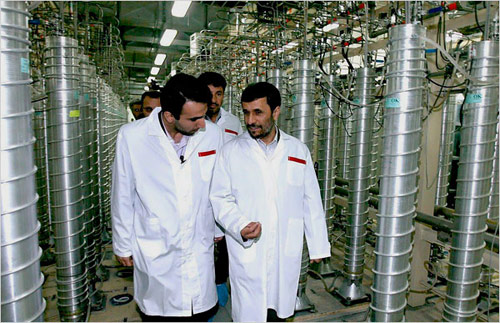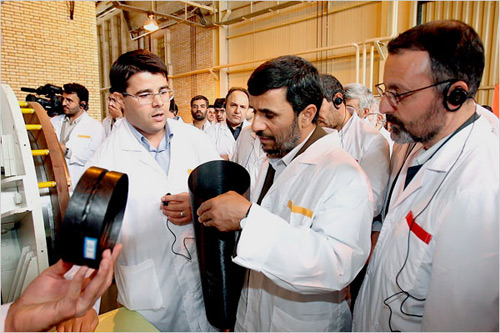Technical Challenges: IR-1 and IR-2 Centrifuges

IR-1 or P1 Centrifuges
During a March 2008 visit to the underground Natanz facility, President Ahmadinejad, accompanied by officials and journalists, walked past rows of IR-1 centrifuges. These first-generation centrifuges were developed in Iran based on a Pakistani model known as the P1. They consist of a tube approximately 2 meters tall containing an aluminum rotor spinning at very high speed, into which uranium hexafluoride is introduced. By spring 2009, 7,000 of these centrifuges had been installed and had enriched 1.2 tons of uranium to 4%.
© Photo: Iran’s Presidency Office / European Pressphoto Agency
Uranium enrichment requires significant technical expertise and high-quality materials. Iran did not choose the easiest or fastest route if its aim was to build a bomb.
The Iranian program relies on two types of centrifuges: IR-1 and IR-2. The IR-1 first-generation centrifuges, in operation at Natanz, were developed from a Pakistani model. Their development was difficult: by spring 2009, 7,000 were installed, up from 3,000 in 2007 — still far fewer than the 54,000 planned in 2006. Iranian engineers faced many setbacks due to the materials used for the rotors, which are subject to accelerations tens of thousands of times stronger than gravity.

IR-2 Centrifuges: Carbon Fiber Rotors
At the pilot enrichment facility in Natanz, housed in above-ground buildings, Mr. Ahmadinejad examines the carbon fiber tube used as the rotor of a new generation of domestically produced centrifuges known as IR-2 (second Iranian generation). The rotor of these centrifuges is about 1 meter long, half the length of IR-1 centrifuges, but spins twice as fast. The carbon fiber rotor is believed to be much more resistant to centrifugal forces than the special steel initially considered.
© Photo: Iran’s Presidency Office / European Pressphoto Agency / NY_Times
Gholamreza Aghazadeh, former head of the Iranian Atomic Energy Organization, recounts: “Our machines frequently broke down during the early days of the program. A study revealed that clusters of microbes, unintentionally left by technicians’ hands during centrifuge assembly, were to blame. This small quantity of microbes was enough to destabilize the rotation and destroy the machine. By destruction, we mean the machine was reduced to powder.”
These challenges led Iran to develop a new type of centrifuge, the IR-2, based on the Pakistani second-generation P2 model. A rotor made of ultra-strong steel allowed faster spinning and increased enrichment capacity while reducing the risk of destruction. However, such steel was difficult to produce. Iran then created its own model, replacing the steel rotor with carbon fiber — a material remarkably strong for its weight.
In September 2009, the Atomic Energy Organization of Iran (AEOI) announced that its scientists had succeeded in producing a new, more efficient generation of centrifuges.
Slowed Production
In late February 2010, during a White House briefing, senior administration officials claimed they had evidence that Iran was struggling to maintain its enrichment equipment. Thousands of centrifuges installed at Natanz, the main enrichment site, were not spinning. The Obama administration said Iran was only producing 100 grams of enriched uranium per day and would still need several years to build a bomb.
Technical issues or sabotage? In 2008, President George Bush, after denying a secret Israeli request for bunker-busting bombs to destroy the underground Natanz facility, reportedly authorized covert sabotage operations to derail Iran’s suspected nuclear weapons development.
The possibility of sabotage was reinforced in November 2010 when reports emerged of a computer virus called STUXNET that allegedly targeted centrifuge operations by disrupting their rotational speeds. The IAEA observed that Iran briefly suspended enrichment after electrical malfunctions, though it was unclear if the virus was responsible. Soon after, on November 29, two nuclear scientists were attacked with bombs by assailants on motorcycles. One was killed (the third in two years) and the other injured. Authorities blamed Mossad and the CIA.
Despite the expertise gained by Iranian engineers, many months of difficult research and development were still needed before these centrifuges could be deployed on a large scale. Their use was expected to multiply enrichment capacity by four.
In January 2013, Tehran informed the International Atomic Energy Agency (IAEA) of its intention to use IR-2m centrifuges in Unit A-22 of the Natanz enrichment facility. This newer generation of centrifuges, designed for low-level enrichment under 5%, was not intended for the Fordo facility. Implementation was to be gradual, with a first batch of 180 IR-2m centrifuges reportedly installed in February 2013.
Before stepping down following the election of President Hassan Rouhani, the head of Iran’s nuclear program, Fereydoun Abbasi Davani, stated on August 17, 2013, that Iran had around 18,000 centrifuges, more than 10,000 of which were operational — figures confirmed by the IAEA. About 1,000 of these, far more efficient, were second-generation models.
After the July 14, 2015 Iran Nuclear Deal
One of the clauses in the agreement significantly limited Iran’s enrichment capacity, requiring the country to forgo its most advanced centrifuges. For four years, IAEA inspections showed Iran complied with the terms. That changed after August 2019. Under heavy economic sanctions imposed by the Trump administration, which withdrew from the deal, Iran announced it was restarting its advanced centrifuges, while remaining under IAEA monitoring and stating that the move was reversible.
June 13, 2025
A 12-Day War: U.S. Bombings on Fordo
Is Iran’s uranium enrichment program aimed at building a nuclear weapon? A much smaller country, North Korea, detonated its first nuclear bomb in 2006. Two decades later, what lies behind accusations of Iran hiding a nuclear weapons program? Reportedly, 400 kg of uranium have been enriched to 60%, still 30% below the 90% required for a bomb. But why enrich 400 kg if they have no civilian use?
By starting a war with Iran, Israeli President Benjamin Netanyahu realized an old ambition. He pushed the Gaza conflict and the Palestinian statehood debate — which he opposed — into the background. Two days later, U.S. President Donald Trump used deep-penetration bombs to strike enrichment facilities at Natanz and Fordo, before halting the bombings on June 25. Whether the sites withstood the attacks remains unknown.
Following the U.S. withdrawal in 2018 from the 2015 Vienna Agreement limiting Iran’s nuclear activities, Iran had shown restraint, maintaining cooperation with the IAEA and allowing inspections of Natanz, Fordo, and other sites.
Talks between U.S. and Iranian officials are reportedly under consideration. Meanwhile, cooperation with the IAEA remains suspended.
Les autres articles sur le sujet « Nuclear Proliferation »
The uranium pathway
Centrifuging and enriching uranium 235 Taking the uranium pathway towards proliferation, the key [...]
The plutonium pathway
Extracting weapon-grade plutonium from spent fuel For the plutonium pathway, the key technology i[...]
North Korea
A country cut off from the world that blows hot and cold… The Democratic People’s Rep[...]